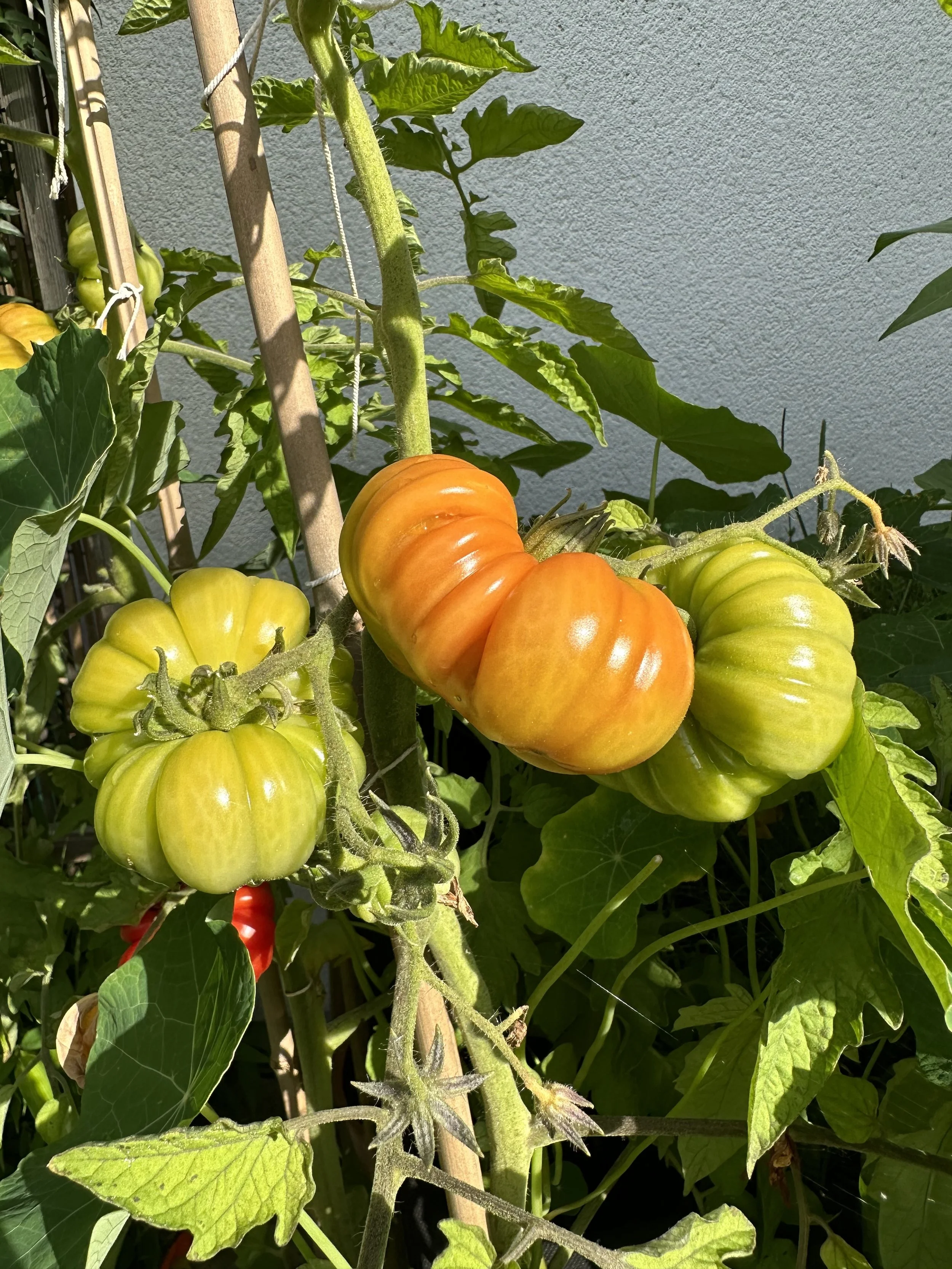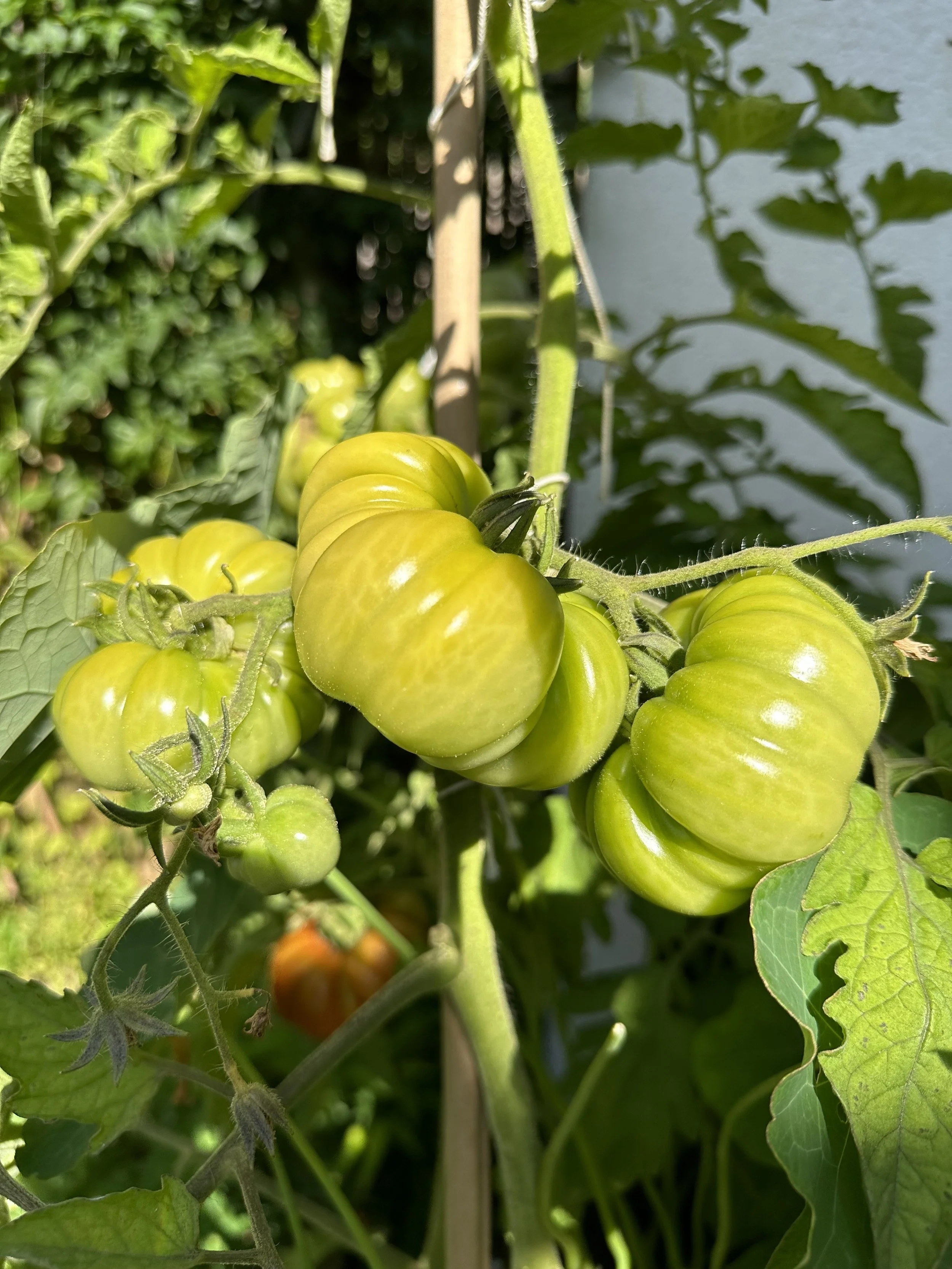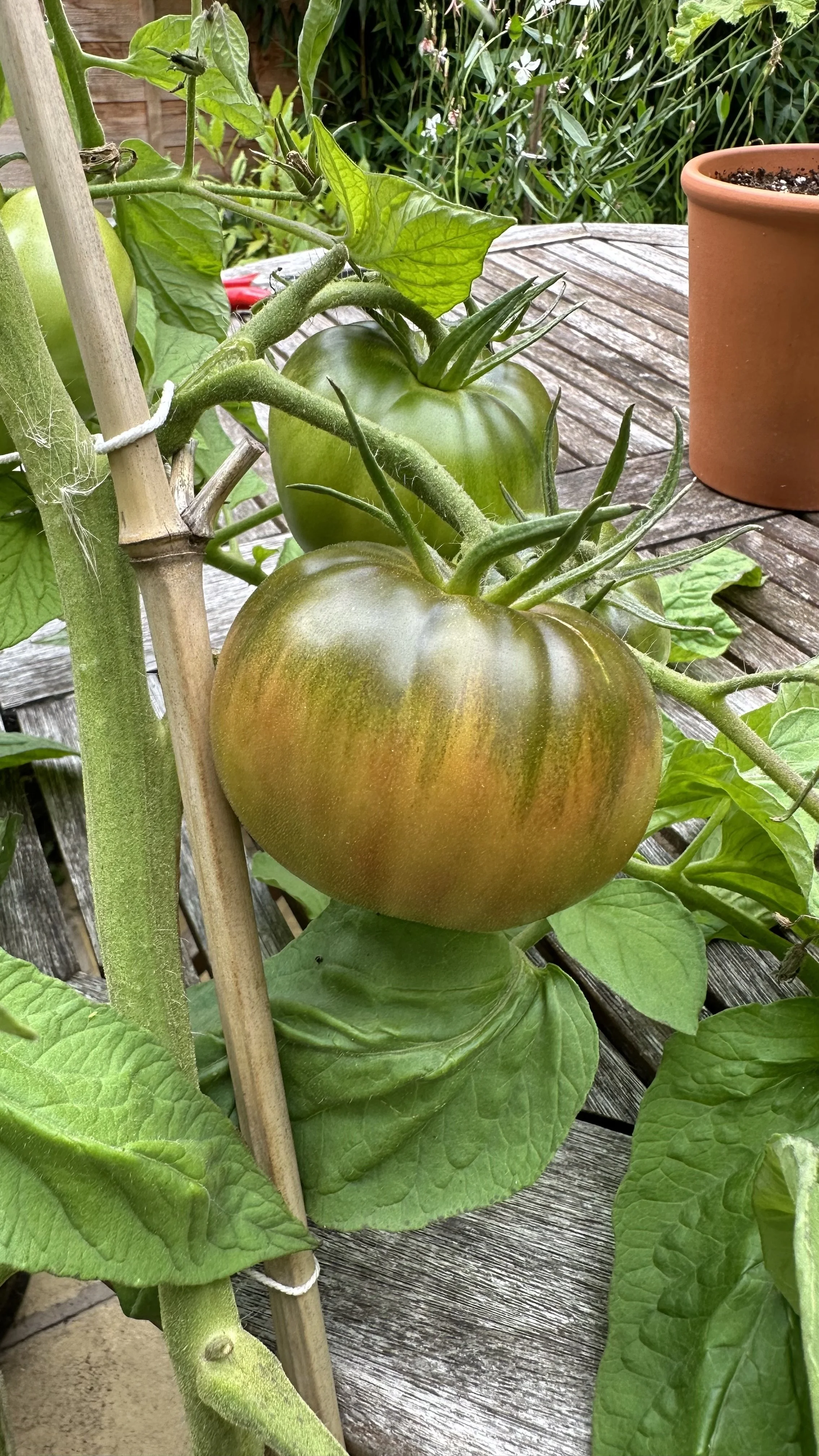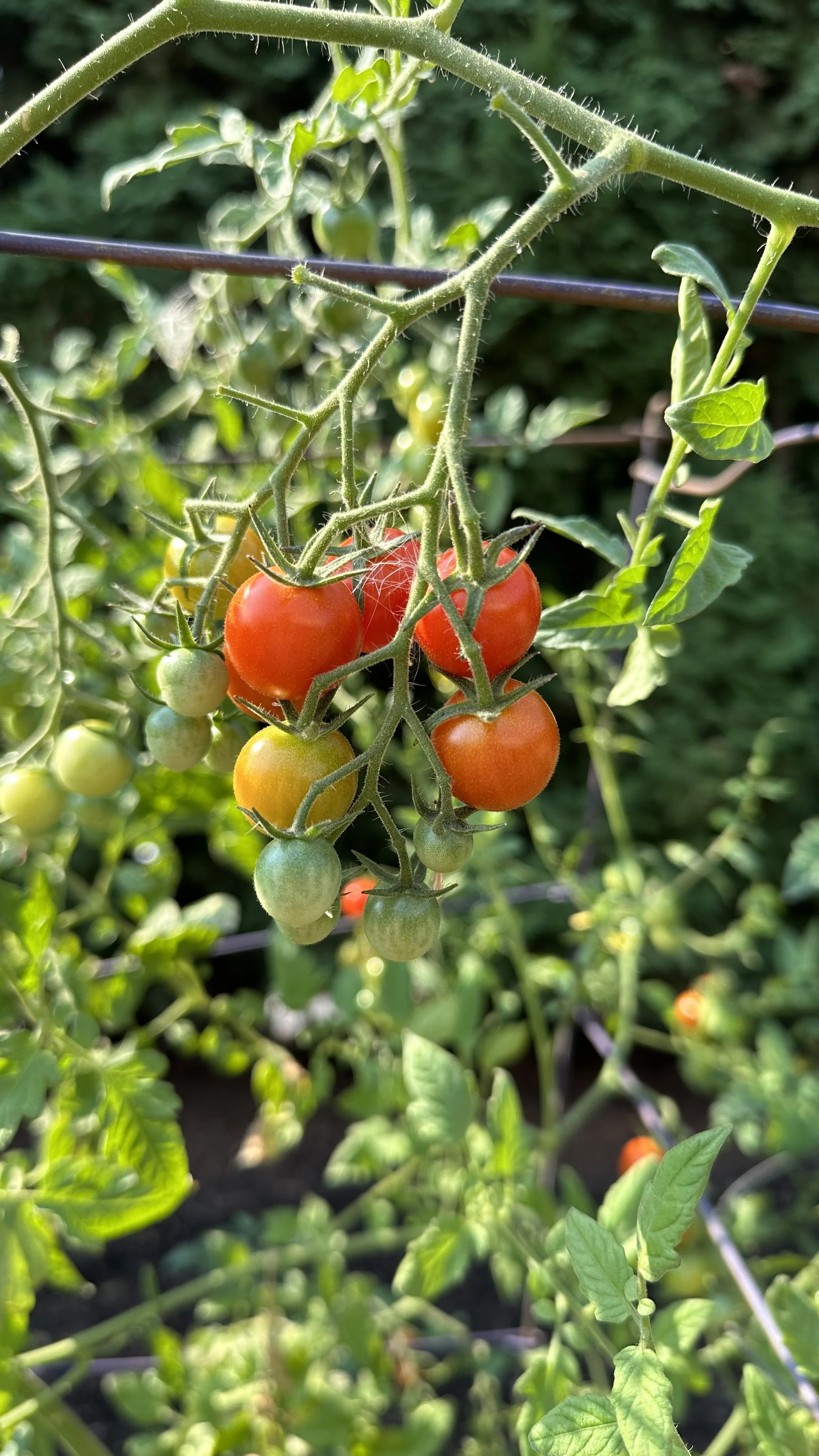When to Harvest Tomatoes
Are you gazing at your flourishing tomato plants, wondering when is the right time to harvest tomatoes?
Or perhaps you're unsure about how to manage your harvest before an imminent frost?
You're not alone.
Harvesting tomatoes is an art, combining timing, temperature and maturity to obtain a fully ripe, flavorful fruit.
Let's dive into the world of harvesting tomatoes and explore the perfect time to pick.
To learn more about growing tomatoes, check out my guides:
Grow Tomatoes Anywhere with Grow Bags
When and How to Harvest Tomatoes
As with many fruits, tomatoes can be tricky to harvest perfectly.
Harvest too early, and you might be left with an underripe, tasteless fruit.
Wait too long, and it could spoil or fall prey to pests.
But fear not, with some knowledge and practice, you'll be picking tomatoes like a pro.
Maturity is Key
Mature green tomatoes are those that have reached their full size but have not yet started to change color.
Harvesting at this stage is generally done when you need to stimulate ripening off the vine, such as when frost is predicted or when dealing with stubborn fruits that don't seem to ripen on the plant.
However, for the fullest flavor and optimal nutritional content, it's best to wait until the tomato is fully ripe.
A ripe tomato will have a uniform color, specific to its variety.
It will also feel slightly soft when gently squeezed and come off the vine easily when given a slight twist.
Keep in mind that the ripening characteristics can vary among different tomato varieties.
Cherry tomatoes, for example, might be red, yellow, or even black when fully ripe, while beefsteak tomatoes usually turn a deep, vibrant red.
Regular Check-ups
To harvest your tomatoes at the right time, it's a good idea to check on your plants regularly.
The process from mature green to fully ripe can take anywhere from a few days to a week, depending on the weather.
During this time, keep a close eye on your tomatoes to make sure you harvest them at the perfect time.
Handle with Care
When it's time to harvest, approach the task with care.
Tomatoes are quite delicate and can easily be bruised or damaged.
Grasp the fruit gently and twist it until it snaps off from the vine.
If you prefer, you can use a pair of sharp garden scissors or pruners to cut the stem above the fruit.
Avoid pulling on the tomato or tugging it hard as it can lead to damaged fruit or harm the plant.
Remember to support the vine with one hand to prevent any accidental damage.
In case of Doubt, Harvest
If you're unsure whether your tomato is ready to be harvested, it's generally better to err on the side of caution and pick it.
An underripe tomato will continue to ripen off the vine if kept at room temperature.
Moreover, picking tomatoes promptly can help reduce the risk of pests or disease affecting your fruit.
Overall, understanding when and how to harvest tomatoes involves a good sense of timing and observation.
By keeping these guidelines in mind, you're sure to enjoy a bountiful harvest of juicy, flavorful tomatoes from your garden.
Ready to harvest more from your garden? Check out my harvest guides:
The Art of Preserving Heat: How to Dry Chillies Perfectly
To learn more about growing tomatoes, check out my guides:
Are Coffee Grounds Good for Tomato Plants?
Quick Homemade Tomato Fertilizer
What Temperature to Harvest Tomatoes
Tomatoes are warm-season plants and they react strongly to temperature changes.
Temperature doesn't just affect the growth of the tomato plants, but it also plays a crucial role in the ripening of the fruits.
The perfect ripening process occurs when daytime temperatures are around 75 to 85 degrees Fahrenheit (24 to 29 degrees Celsius) and nighttime temperatures hover around 60 to 70 degrees Fahrenheit (15 to 21 degrees Celsius).
At these temperatures, the tomato's natural ethylene gas production accelerates, triggering the ripening process and the development of color.
Cold and Heat Effects
When temperatures fall below 50 degrees Fahrenheit (10 degrees Celsius), tomatoes will take longer to ripen and may not develop their full color.
In contrast, when temperatures soar above 86 degrees Fahrenheit (30 degrees Celsius), the ripening process can be inhibited, causing the tomatoes to remain green for a prolonged period.
Harvesting in Extreme Temperatures
If you're experiencing unusually high or low temperatures, it may be best to pick your tomatoes in their mature green stage and allow them to ripen off the vine indoors.
This indoor ripening can be facilitated by placing green tomatoes in a paper bag at room temperature.
The enclosed space will trap ethylene gas, which aids in the ripening process.
You can even add a ripe apple or banana to the bag to increase the ethylene gas concentration and speed up ripening.
Consistent Temperature is Key
Overall, maintaining a consistent temperature is key to successful tomato ripening.
Fluctuations can lead to problems such as splitting or blossom end rot.
Monitoring and, when necessary, adjusting your garden's temperature will result in healthier plants and a more abundant, flavorful harvest.
To sum up, temperature significantly influences the tomato ripening process.
By understanding its role, you can strategically harvest your tomatoes to ensure the best flavor and texture, even when weather conditions are not ideal.
One of my favorite tomatoes to grow:
To learn more about growing tomatoes, check out my guides:
Why is My Tomato Plant Not Flowering?
How to Harvest Tomatoes at Home
Harvesting tomatoes at home requires no more than a delicate hand and perhaps a pair of garden shears for stubborn stems.
Gently grasp the fruit and twist it until it breaks free from the stem.
For clusters of cherry tomatoes, it's often easier to remove the entire cluster from the plant when the majority of fruits are ripe.
Recognizing the Right Time
The first step is recognizing when your tomatoes are ready to harvest.
Depending on the variety, ripe tomatoes should be uniform in color (this can range from red to yellow, orange, or even purple) and slightly firm to the touch.
Another helpful tip is to pay attention to the bottom of the tomato.
This part of the fruit usually ripens last. So, when the bottom matches the color of the rest of the tomato, it's a clear sign of ripeness.
The Picking Process
When you're ready to pick your tomatoes, approach the plant gently.
Grasp the fruit lightly but firmly and twist it until the stem snaps.
It's important not to pull on the tomato, as this can damage the fruit or the plant.
For stubborn stems or larger tomatoes, you might want to use a pair of gardening shears or scissors.
Simply snip the stem above the fruit, taking care not to cut into the tomato itself.
These are the perfect shears for the job:
Special Considerations for Different Varieties
For smaller tomato varieties like cherry or grape tomatoes, it's often best to remove the whole cluster from the plant when most of the tomatoes are ripe.
In contrast, larger varieties like beefsteak tomatoes are generally harvested individually due to their size and weight.
After the Harvest
Once you've harvested your tomatoes, handle them with care to avoid bruising or damaging them.
Don't stack them too high, as the weight can cause the ones at the bottom to squish.
Also, remember that tomatoes continue to ripen after being picked.
So, store them at room temperature, away from direct sunlight until they reach the desired level of ripeness.
Frequent Harvesting
Frequent harvesting encourages the plant to produce more fruit.
So, once your tomatoes start ripening, check your plants regularly and pick ripe fruit promptly.
This will allow more nutrients to go to the remaining tomatoes, leading to a healthier and more productive plant.
In essence, harvesting tomatoes at home is all about timing, gentle handling, and regular checks.
With these practices, you can enjoy a fruitful tomato season and the unbeatable taste of homegrown tomatoes.
For more inspiration, check out my guide:
How to Harvest Tomato Seeds
To harvest tomato seeds for future planting, select a fully ripe tomato from a variety that you would like to grow again.
Cut the tomato in half and scoop or squeeze out the seeds, placing them into a jar with a little water.
After a few days, rinse off the fermented pulp from the seeds, let them dry, and store them for future planting.
Here is more on how to do this:
Choose the Right Tomato
Start by selecting a fully ripe, healthy tomato from your desired variety.
It's best to choose a tomato from a plant that has shown strong vigor, disease resistance, and high-quality fruit.
Remember, you should only save seeds from open-pollinated or heirloom tomatoes, not hybrid varieties.
Hybrids may not produce plants with the same characteristics as the parent plant.
Harvesting the Seeds
Cut the selected tomato in half across the middle, not from stem to blossom end.
This exposes the cavities within the tomato that house the seeds.
Gently squeeze each half, or scoop out with a spoon, to remove the pulp and seeds.
Put this mixture into a small, clean container like a glass or jar.
Fermenting the Seeds
Add a small amount of water to the container and let it sit at room temperature for about three to five days.
During this time, a layer of mold will likely form on the surface.
This fermentation process is necessary as it helps remove the gelatinous sack that surrounds each tomato seed.
This sack contains chemicals that inhibit seed germination, so it's essential to remove it.
Stir the container each day to aerate the mixture and speed up the fermentation process.
Make sure to keep an eye on the process, as too long of a fermentation period can cause the seeds to germinate prematurely.
Cleaning and Drying the Seeds
After fermentation, fill the container with warm water.
The viable seeds will sink to the bottom, while the pulp and non-viable seeds will float.
Pour off the floating matter and excess water.
Repeat this process until only clean seeds remain.
Once cleaned, strain the seeds and spread them out to dry on a paper plate or screen.
Avoid using paper towels, as the seeds may stick to the paper as they dry.
Storing the Seeds
Allow the seeds to dry completely, which can take up to two weeks.
Stir them occasionally to ensure they dry evenly and don't clump together.
Once dry, store your seeds in a cool, dry place.
You can place them in envelopes, small cloth bags, or glass jars.
Make sure to label your seeds with the tomato variety and the date you saved them.
With these steps, you can save and plant your favorite tomato varieties year after year.
This process not only helps preserve heirloom varieties, but it can also develop tomato plants that are increasingly well adapted to their local growing conditions.
Learn when to start tomato seeds indoors with my guide to When to Start Tomato Seeds Indoors.
For more tips, check out my guide:
How Early Can You Harvest Tomatoes
Harvesting tomatoes too early may result in a less flavorful fruit.
It's best to wait until your tomatoes have reached the mature green stage at the very least.
After this point, they should be able to ripen off the vine if necessary.
Mature Green Stage
Tomatoes can technically be harvested as soon as they reach the "mature green" stage.
At this point, the tomatoes have attained their full size but have not yet started to change color.
They will feel firm to the touch and their interior color will have a white to light green hue.
Harvesting tomatoes at this stage is common when you want to induce ripening off the vine, perhaps to get a head start on a dinner plan, or when frost is predicted and you need to save your crop.
Once picked, mature green tomatoes can be ripened off the vine at room temperature.
Storing them in a paper bag can accelerate the process, as can adding a ripe apple or banana to the bag, both of which give off ethylene gas which promotes ripening.
For Optimal Flavor
However, for the best flavor and texture, it's advisable to wait until tomatoes are fully ripe before harvesting.
This is when they have developed their full, variety-specific color and give slightly under gentle pressure.
This stage usually occurs around 20 to 30 days after the mature green stage, depending on the variety and growing conditions.
Early Varieties
Some tomato varieties are classified as "early" because they produce ripe fruit sooner than others.
Varieties like 'Early Girl', 'Stupice', or 'Glacier' can produce ripe fruit in as little as 50 to 60 days after transplanting, whereas "main season" varieties may take 70 to 80 days or longer.
Note, however, that these are just averages.
The actual time to harvest can depend on numerous factors including the specific variety, the local climate, and the care the plants receive.
To sum up, how early you can harvest tomatoes depends on the specific circumstances.
If you need tomatoes earlier for any reason, you can pick them at the mature green stage.
Otherwise, for the best flavor, it's worth waiting until they are fully ripe.
When is the Latest to Harvest Tomatoes
The latest time to harvest tomatoes often corresponds with the first frost of the season, as frost will kill the tomato plants and damage the fruit.
Frost times can vary widely depending on your geographic location, so it's essential to monitor local weather forecasts as summer transitions into fall.
Here's what to do when the first frost threatens your tomato harvest:
Harvesting Before Frost
When frost is in the forecast, it's best to harvest all of your tomatoes, even those that are still green.
Mature green tomatoes, which have reached their full size but haven't changed color yet, can still ripen off the vine.
Ripening Green Tomatoes Indoors
After harvesting, you can ripen your green tomatoes indoors.
Store them in a warm, dry place, ideally at temperatures between 55 and 70 degrees Fahrenheit (13 to 21 degrees Celsius).
A paper bag, box, or drawer will work for this. For faster ripening, add an apple or banana to the bag or box with the tomatoes.
These fruits emit ethylene gas, a natural hormone that aids in the ripening process.
Using Unripe Tomatoes
Not all green tomatoes will ripen indoors, especially those that were not at the mature green stage when picked.
However, unripe tomatoes can still be used in a variety of dishes.
Green tomato salsa, chutney, and the classic fried green tomatoes are just a few examples.
Overwintering Tomato Plants
In some mild climates, certain tomato varieties can be overwintered for a new crop the following year.
However, for most home gardeners dealing with cold winters, tomato plants are annual plants that complete their life cycle in one growing season.
So, the latest to harvest tomatoes is typically just before the first frost of the season.
With some preparation and a keen eye on the weather forecast, you can ensure a full harvest and savor your homegrown tomatoes well into the colder months.
After Harvest: What To Do After Harvesting Tomatoes
Once picked, tomatoes should be stored at room temperature to preserve their flavor and texture.
Refrigeration can make tomatoes mealy.
If you've harvested green tomatoes, place them in a paper bag with a ripe banana or apple.
The ethylene gas produced by these fruits will speed up the ripening process.
Storing Tomatoes
When storing tomatoes, remember they continue to ripen after being harvested.
If your tomatoes are fully ripe, they should be used within a few days to enjoy them at their peak.
If you've picked your tomatoes at a mature green stage, they can be ripened at room temperature away from direct sunlight.
Refrigerating tomatoes is generally not recommended as it can alter their texture and flavor.
However, if your tomatoes are overly ripe and you cannot use them immediately, refrigeration can help prolong their usability.
Using Harvested Tomatoes
Tomatoes can be utilized in a variety of dishes - from salads and salsas to sauces and soups.
If you have an abundant harvest, consider preserving them for future use.
Tomatoes can be canned, made into tomato sauce or paste, or even sun-dried and stored in oil.
For green tomatoes, a popular choice is to make fried green tomatoes.
You could also pickle green tomatoes or use them in relishes.
Saving Tomato Seeds
If you grew an heirloom or open-pollinated variety that you particularly liked, consider saving seeds for next year's planting.
Remember to choose a fully ripe, healthy tomato to harvest the seeds from.
Refer to the guide above for detailed instructions on harvesting tomato seeds.
Post-Harvest Garden Care
After harvesting, it's essential to clean up the garden area.
Remove any plant debris, including fallen tomatoes and leaves, to reduce the chance of disease in the following growing season.
It's also a good time to assess your garden.
Did the tomato plants receive enough sun?
Were there any issues with pests or diseases?
The end of the growing season is the perfect time to make notes and plan for next year's garden.
Want to learn more about growing tomatoes in containers? Check out my guide to Tomato Grow Bags.
In conclusion, after harvesting tomatoes, proper storage, efficient usage, and adequate garden care can ensure that you maximize the benefits of your hard work in the garden.
The end of the harvest season is not the end but a transition into preparation for the next growing season.
FAQs
What is the best time of day to pick tomatoes?
The best time to pick tomatoes is in the early morning when the fruit is cool.
This is because the cool temperatures of the morning help to preserve the freshness and flavor of the tomatoes.
In the heat of the day, the plants are stressed and their respiration rates are high, which can reduce the overall flavor and quality of the fruit.
Therefore, it's best to pick your tomatoes before the day gets too hot.
After picking, handle your tomatoes carefully to avoid bruising them, and don't store them in direct sunlight or in a very hot place, as this can lead to the fruit over-ripening or spoiling.
It's also best not to refrigerate fresh tomatoes, as this can cause them to lose flavor and develop a mealy texture.
Instead, store them at room temperature until you're ready to use them.
Remember, a gentle twist should be enough to release a ripe tomato from the vine.
If you have to pull hard, the tomato is likely not ripe and should be left a little longer.
Do tomatoes ripen off the vine?
Yes, tomatoes can continue to ripen off the vine, which is often necessary when a frost is looming and you need to harvest all the tomatoes from your plants, including those that are still green.
When tomatoes reach their "mature green" stage, where they've attained full size but have not yet started to change color, they can be harvested and will ripen off the vine.
They should be stored at room temperature in a spot away from direct sunlight for this ripening process.
The warmer the spot (up to a point), the faster the tomatoes will ripen.
For quicker ripening, you can place the tomatoes in a paper bag, box, or drawer.
Adding a ripe banana or apple can expedite the process as these fruits emit ethylene gas, a natural plant hormone that aids in ripening.
It's worth noting that while tomatoes can ripen off the vine, vine-ripened tomatoes are often considered to have the best flavor.
This is because the sugars and other flavor compounds in tomatoes continue to develop right up until the tomato is fully ripe.
Therefore, if conditions allow, it's typically best to let your tomatoes ripen on the vine as long as possible for the best flavor.
Can you pick cherry tomatoes when they are green?
Yes, you can pick cherry tomatoes when they are green, but it's important to note that they should be at the "mature green" stage for best results.
This means they have reached their full size but have not yet started to change color.
After picking, green cherry tomatoes can be ripened off the vine at room temperature.
If you want to accelerate the ripening process, you can put them in a paper bag with a ripe banana or apple, both of which release ethylene gas, a natural plant hormone that encourages ripening.
However, for the best flavor, it is generally advised to allow cherry tomatoes to ripen on the vine.
The sugars and other flavor compounds continue to develop right up until the fruit is fully ripe, resulting in a sweeter, richer flavor.
It's also important to note that some varieties of cherry tomatoes are actually green when fully ripe, such as 'Green Grape' or 'Green Zebra'.
These will not turn red and should be harvested based on size and a slight give when they are gently squeezed.
How to Harvest Tomatoes Before Frost?
As temperatures drop, your green tomatoes may not have enough time to fully ripen on the vine.
However, you can still salvage your harvest.
Pick tomatoes when they have reached the mature green stage.
Bring them inside and allow them to ripen at room temperature away from direct sunlight.
What is the Best Time to Harvest Tomatoes?
The best time to pick tomatoes is when they are fully ripe but still firm to the touch.
However, you can also harvest mature green tomatoes and allow them to ripen off the vine.
Cherry tomatoes should be harvested when they are uniformly colored, while beefsteak tomatoes can be picked when they have a full, deep color and give slightly under hand pressure.
Can You Harvest Tomatoes Green?
Yes, you can harvest tomatoes green. While they won't have the full flavor of a vine-ripened fruit, green tomatoes have their own culinary uses.
For example, fried green tomatoes are a delicious southern classic.
Check out my guide Are Coffee Grounds Good for Tomato Plants?
Wrap-up
In conclusion, understanding the dynamics of when and how to harvest tomatoes is crucial.
Observing your tomatoes as they ripen, knowing the optimal temperature conditions, and recognizing the signs of a ripe tomato are all essential for reaping a successful, flavorful harvest.
From the initial stage of picking mature green tomatoes, through to the fully ripe phase, each step of the harvesting process requires care and attention.
Whether it's savoring the vibrant flavor of a freshly picked tomato or enjoying the delayed gratification of ripening green tomatoes indoors, each tomato harvest presents its unique joys.
Furthermore, the act of harvesting isn't the end of your tomato journey.
With the right care, picked tomatoes can be stored, used in a multitude of dishes, or their seeds saved for future planting.
Remember, the more you understand the life cycle of your tomatoes, the more successful you will be in your gardening endeavors.
Here's to a bountiful harvest and the pleasure of tasting perfectly ripe, homegrown tomatoes, right from your garden to your table.
Battling with leggy tomato seedlings?
Check out my guide to Leggy Tomato Seeds: Causes and Solutions.








































